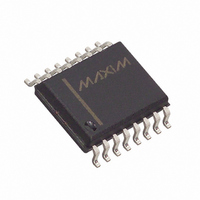MAX110BCWE+ Maxim Integrated Products, MAX110BCWE+ Datasheet - Page 17

MAX110BCWE+
Manufacturer Part Number
MAX110BCWE+
Description
IC ADC SERIAL 2CH 14BIT 16-SOIC
Manufacturer
Maxim Integrated Products
Datasheet
1.MAX110BCPE.pdf
(24 pages)
Specifications of MAX110BCWE+
Number Of Bits
14
Sampling Rate (per Second)
50
Data Interface
MICROWIRE™, QSPI™, Serial, SPI™
Number Of Converters
1
Power Dissipation (max)
762mW
Voltage Supply Source
Single Supply
Operating Temperature
0°C ~ 70°C
Mounting Type
Surface Mount
Package / Case
16-SOIC (0.300", 7.50mm Width)
Number Of Adc Inputs
2
Architecture
Delta-Sigma
Conversion Rate
0.05 KSPs
Resolution
14 bit
Input Type
Differential
Interface Type
3-Wire (SPI, QSPI, MICROWIRE)
Voltage Reference
External
Supply Voltage (max)
5 V
Maximum Power Dissipation
762 mW
Maximum Operating Temperature
+ 70 C
Mounting Style
SMD/SMT
Minimum Operating Temperature
0 C
Lead Free Status / RoHS Status
Lead free / RoHS Compliant
* Gain-calibration mode is not available with 102,400 clock cycles/conversion selected.
The data sheet electrical specifications apply to the
device after optional calibration of gain error and offset.
Uncalibrated, the gain error is typically 2%.
Table 3 describes the three steps required to calibrate
the ADC completely.
Once the ADC is calibrated to the selected channel, set
CAL = 0 and NUL = 0 and leave CHS unchanged in the
next control word to perform a signal conversion on the
selected analog input channel.
Calibrate the ADC after the following operations:
Table 5. Clock Divider-Ratio Control
—
—
—
—
—
—
Table 4. Available Conversion Times
Clock duty cycles of 50% ±10% are recommended.
CONV4 CONV3 CONV2 CONV1
when power is first applied
if the reference common-mode voltage changes
after changing conversion speed/resolution.
channel varies significantly. The CMRR of the analog
inputs is 0.25LSB/V.
ages of the two channels are different)
drift with temperature is typically 0.003µV/°C.
if the common-mode voltage of the selected input
after changing channels (if the common-mode volt-
after significant changes in temperature. The offset
1
0
0
0
DV2
0
0
1
1
0
0
1
0
DV4
0
1
0
1
Low-Cost, 2-Channel, ±14-Bit Serial ADCs
______________________________________________________________________________________
0
1
1
0
XCLK or internal RC oscillator connects directly to the ADC; f
XCLK or internal RC oscillator is divided by 4 and connects to the ADC; f
XCLK or internal RC oscillator is divided by 2 and connects to the ADC; f
Not allowed
1
1
0
0
3-Step Calibration
CLOCK CYCLES
CONVERSION
102,400*
10,240
20,480
81,920
PER
RCSEL = GND, DV2 = DV4 = 0, XCLK = 500kHz
NOMINAL CONVERSION TIME
Automatic gain calibration is not allowed in the
102,400 cycles per conversion mode (see
Programming Conversion Time ). In this mode, calibra-
tion can be achieved by connecting the reference volt-
age to one input channel and performing a normal
conversion. Subsequent conversion results can be cor-
rected by software. Do not issue a N N O O - - O O P P command
directly following the gain calibration, as the cali-
bration data will be lost.
The MAX110/MAX111 are specified for 12 bits of accu-
racy and up to ±14 bits of resolution. The ADC’s resolu-
tion depends on the number of clock cycles allowed
during each conversion. Control-register bits 9–12
(CONV1–CONV4) determine the conversion time by
controlling the nominal number of oversampling clock
cycles required for each conversion (OSCC/CONV).
Table 4 lists the available conversion times and result-
ing resolutions.
To program a new conversion time, perform a 3-step
calibration with the appropriate CONV1–CONV4 data
used in Table 3. The ADC is now calibrated at the new
conversion speed/resolution.
DESCRIPTION
163.84
204.80
20.48
40.96
(ms)
OSC
Programming Conversion Time
= f
XCLK
OSC
OSC
.
= f
= f
XCLK
XCLK
4.
2.
CONVERSION
RESOLUTION
12 + POL
13 + POL
14 + POL
14 + POL
(Bits)
17











